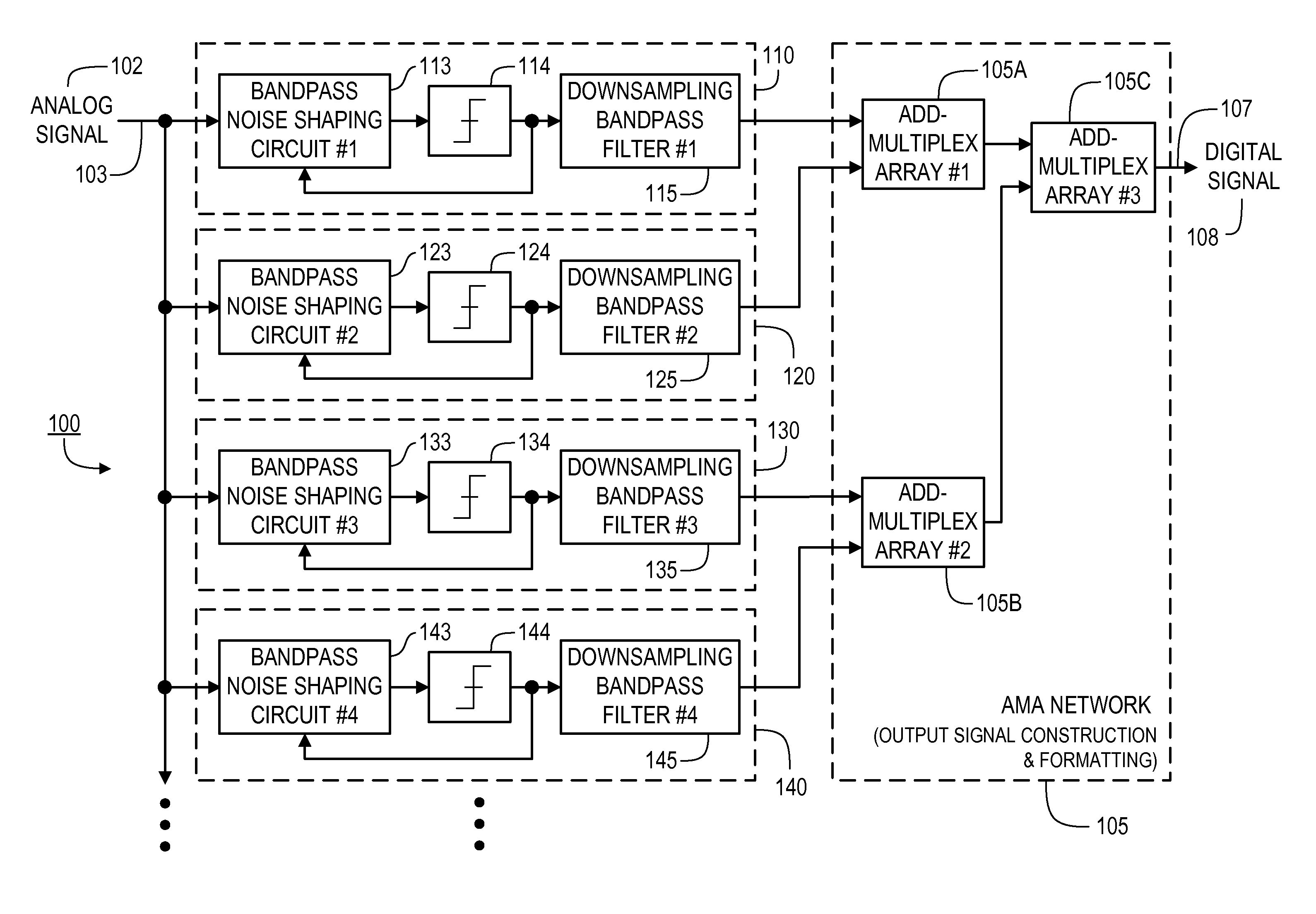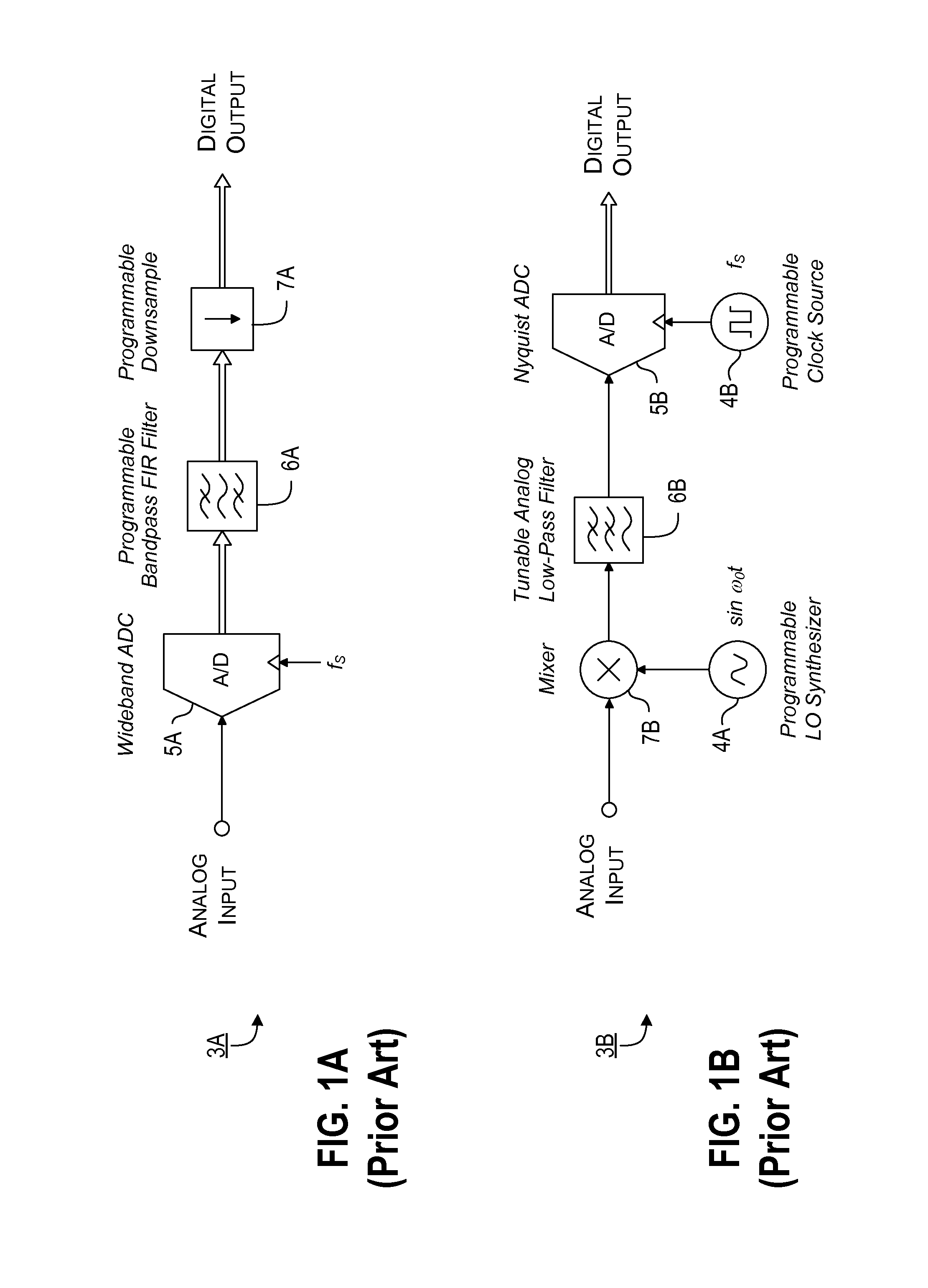[0013]The present invention addresses these needs by providing improved systems, methods, apparatuses and techniques for conversion of continuous-time signals to discrete-time signals, particularly for use in multi-mode data converter applications.
[0014]In one specific embodiment, the invention is directed to an apparatus for converting a continuous-time, continuously variable input signal into a sampled and quantized output signal, where the continuous-time, continuously variable input signal can vary in center frequency and bandwidth. In this embodiment, the apparatus: (1) decomposes the input signal into distinct frequency subbands that span (encompass) the desired input signal frequency range; (2) independently processes each frequency subband, and then (3) combines the frequency subbands to preserve the input signal bandwidth and construct an output signal representing a quantized, baseband version of the input signal. The apparatus includes: (1) an input line for accepting an input signal that is continuous in time and continuously variable; (2) a plurality of processing branches coupled to the input line; and (3) an output Add-Multiplex Array (AMA) Network coupled to outputs of the plurality of processing branches, with each of the processing branches including: (a) a continuous-time, quantization-noise-shaping circuit, (b) a sampling / quantization circuit coupled to the output of the continuous-time quantization-noise-shaping circuit, (c) a digital, downsampling bandpass filter coupled to an output of the sampling / quantization circuit, and (d) one or more lines coupling the input and output of the sampling / quantization circuit back into the continuous-time, quantization-noise-shaping circuit. The output AMA Network includes a plurality of add-multiplex arrays that combine the outputs of processing branches, or alternatively, combine the outputs of other add-multiplex arrays, with each of the add-multiplex arrays including: (a) a multi-input adder coupled to a set of input lines, (b) a first, multi-input multiplexer coupled to the same set of input lines, and (c) a second, multi-input multiplexer coupled to the outputs of the adder and to the outputs of the first multiplexer. The continuous-time, quantization-noise-shaping circuits in different ones of the processing branches produce quantization noise minima at different frequencies that vary depending on the spectrum (i.e., center frequency and bandwidth) of the input signal, and the quantization noise minimum for each of the continuous-time, quantization-noise-shaping circuits corresponds to a frequency band, or subband, selected by the digital bandpass filter in the same processing branch.
[0015]In such an apparatus, the frequency bands processed by the various branches depend on the input signal center frequency and bandwidth, and are configured to span, or approximately span, the frequency range of the input signal. The various branches are configured to process narrow frequency bands for narrowband input signals, and are configured to process proportionally wider frequency bands for wideband input signals. Also, the various branches are configured so that the frequency bands are localized at or near the center frequency of the input signal. Configuration of the various processing branches in this manner enables narrowband input signals to be converted with higher resolution than wideband input signals. In multi-mode converter applications, such a reconfigurable apparatus typically can provide a better combination of high resolution and wide input bandwidth than is possible with conventional multi-mode converters. Such an apparatus can be used for various commercial, industrial and military applications, e.g., in various direct conversion sensors, software-defined or cognitive radios, multi-channel communication receivers, all-digital RADAR systems, high-speed industrial data acquisition systems.
[0016]In a somewhat more generalized embodiment, the invention is directed to an apparatus for converting a continuous-time, continuously variable signal into a sampled and quantized signal, and includes: an input line for accepting an input signal that is continuous in time and continuously variable; a plurality of processing branches coupled to the input line; and a combining circuit, coupled to outputs of a plurality of the processing branches, that combines signals on such outputs into a final output signal. Each of such processing branches includes: (a) a continuous-time quantization-noise-shaping circuit, (b) a sampling / quantization circuit coupled to an output of the continuous-time quantization-noise-shaping circuit, and (c) a digital bandpass filter coupled to an output of the sampling / quantization circuit. In addition, each of a plurality of the continuous-time quantization-noise-shaping circuits includes an adjustable circuit component which, when adjusted, changes a frequency of a quantization-noise frequency-response minimum of such continuous-time quantization-noise-shaping circuit; and each of a plurality of the digital bandpass filters includes at least one adjustable parameter which, when adjusted, changes a frequency passband of such digital bandpass filter.
 Login to View More
Login to View More  Login to View More
Login to View More 


